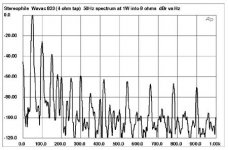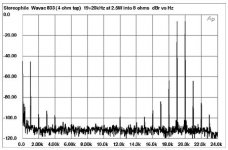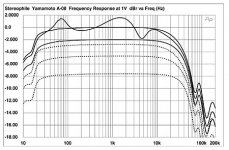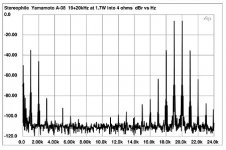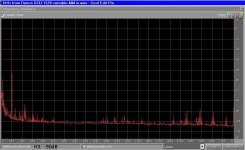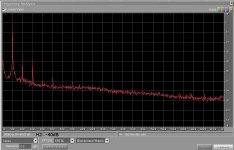compare input to output by ear.
How do you do that?
Or is that what we've been talking about? "Sounds more like a real voice, violin, cello, whatever."
BTW, the earth IS flat. And I can prove it.
Probably its imperfections that do that, but isn't life imperfect?
Sorta like Sharon Stone, no matter how many times you've seen the dame, it doesn't stick.
I.e., 99.9% of them. 😀
Not nearly as high a percentage when you exclude store-bought, or when you multiamp.
You have to include complementary impedance as well... too low an output impedance will give non-flat, overdamped response on some speakers... the variable TransAmp is a thing of beauty.
dave
If the output is significantly different than the input, it's colored. You may like the color, but it's colored. This is true not just for electronics, but data storage and replay (to get back to topic). One may like certain colorations, but colorations they are.
In a properly implemented single-ended system there is little or no color because the distortion will be so low as to be inaudible. That's why I'm not hearing any color. A first-rate analog system doesn't add color because the distortion is too low to hear as well as the noise. CD is like sex with a prostitute - convenient with little effort required but somehow there's an air of detachment and little satisfaction.
John
In a properly implemented single-ended system there is little or no color because the distortion will be so low as to be inaudible. That's why I'm not hearing any color.
Here's what $350k will buy you.
Attachments
Anyone can cite bad amps of any topology and good amps of another. That has little to do with the topologies as a whole. Useless example in a general context.
if you're here for Lone Star, I'll set it up for you.
Alas, I won't be. It would be fun.
Instead I'll be in England, proving the earth is flat. Or banana shaped, I'm not sure.
Why does Stereophile insist on testing SET amps with 4Ω on the 8Ω tap and vice versa? To me that falls under the heading of "Improper Implementation".
John
John
Ignoring the "simulated speaker load"?
OK, those were two amps that got rave reviews. Show me 1W IMD and frequency response into a speaker load for one of those good amps that I apparently ignored.
OK, those were two amps that got rave reviews. Show me 1W IMD and frequency response into a speaker load for one of those good amps that I apparently ignored.
I'm still stuck on the 48Khz to 44.1Khz downsampling that that normally has to take place to make a CD. Can it be the cause of so much that is disliked in CD sound?
If an LP is made from a digital master, the master is not likely to be sample rate converted before being sent to the lathe. Also in all those famous tests where an analog to PCM to analog conversion was inserted into the signal path, and no difference heard, had no down sampling, AFAIK.
Just wondering if that has much to do with it? The quality of sample rate converters is a big topic in the pro world.
If an LP is made from a digital master, the master is not likely to be sample rate converted before being sent to the lathe. Also in all those famous tests where an analog to PCM to analog conversion was inserted into the signal path, and no difference heard, had no down sampling, AFAIK.
Just wondering if that has much to do with it? The quality of sample rate converters is a big topic in the pro world.
Instead I'll be in England, proving the earth is flat. Or banana shaped, I'm not sure.
There, likely all you have to do to find out, is bend over in a perfect 90 degree angle in a public loo.
Ignoring the "simulated speaker load"?
OK, those were two amps that got rave reviews. Show me 1W IMD and frequency response into a speaker load for one of those good amps that I apparently ignored.
Not knowing the nature of the "simulated speaker load", I can't comment. I don't see anything on the Yamamoto response curve that would necessarily be audible, given the far more grotesque variations in speaker and room response. As for the Wavac, I don't know if I'd like a class A2 amp with loads of cathode negative feedback. Big and impressive doesn't make a big impression on me. A high powered SET amp is neither necessary nor desirable.
Speaking of ignoring, there's a lot more ignoring of the more salient points in my posts on this thread.
John
Last edited:
Comparison
I made a 1kHz tone in Cooledit, cut it to a CDR and played it back on my old Denon DCD1520 player, sent the signal through a buffer and transformer coupled to the computers sound card. Made a recording in the computer and analyzed the resulting wave file with Cooledit.
I made a 1kHz tone in Cooledit, cut it to a CDR and played it back on my old Denon DCD1520 player, sent the signal through a buffer and transformer coupled to the computers sound card. Made a recording in the computer and analyzed the resulting wave file with Cooledit.
Attachments
Last edited:
Comparison
Then sent the same signal from the CD player (padded down) to the MM input in my preamplifier and analyzed in the computer.
Then sent the same signal from the CD player (padded down) to the MM input in my preamplifier and analyzed in the computer.
Attachments
Last edited:
Comparison
I dug out an old Realistic test LP in good shape from the early seventies and played the 1kHz track on my Denon DP2000 record player, with an SME III /Shure V15 type IV combination. Recorded and analyzed in Cooledit.
I dug out an old Realistic test LP in good shape from the early seventies and played the 1kHz track on my Denon DP2000 record player, with an SME III /Shure V15 type IV combination. Recorded and analyzed in Cooledit.
Attachments
I recently attended a talk given by a global warming scientist. In his talk, he told us a story about when he and his team were asked to investigate the loss in efficiency through a valve. Their hypothesis was that the valve was loosing energy through its body. They analyzed it, studied it, formulated a set of equations that modeled the behavior of the valve perfectly. The equations predicted the operation of the valve and its efficiency perfectly. They came back with a whole theory of how heat is being lost from the valve.
When they presented the data to their chief engineer, he asked if there was any leakage in the actual action of the valve. They were stumped. They went back and measured the right thing and found that the leakage was so large that heat loss from the valve body was mere noise in comparison.
Now, if the observed data is screaming at you, trying to tell you something, you don't dismiss it until it fits your theories. You change your theory to fit the data. The data in this case being the observation and positive experience of many people with vinyl (and you can add SETs). Rather than dismissing these people as being foolish and having halucinations, we need to investigate why it is so. Our usual measurements are telling us that it should not sound good, but it does. We need to ask the question why.
When they presented the data to their chief engineer, he asked if there was any leakage in the actual action of the valve. They were stumped. They went back and measured the right thing and found that the leakage was so large that heat loss from the valve body was mere noise in comparison.
Now, if the observed data is screaming at you, trying to tell you something, you don't dismiss it until it fits your theories. You change your theory to fit the data. The data in this case being the observation and positive experience of many people with vinyl (and you can add SETs). Rather than dismissing these people as being foolish and having halucinations, we need to investigate why it is so. Our usual measurements are telling us that it should not sound good, but it does. We need to ask the question why.
- Status
- Not open for further replies.
- Home
- Source & Line
- Analogue Source
- How better is a Turntable compared to a CD?
